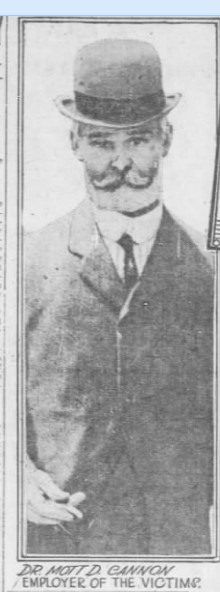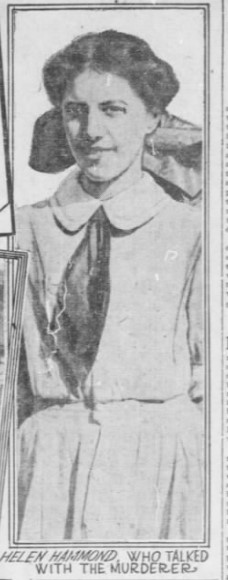On the evening of 9 May 1910, as Dr. Mott Cannon headed back to his New York house, he did not know the grisly sight that awaited him. It was 5.45 p.m. and he was accompanied by one of his lodgers, Julia Freeborn, a local schoolteacher.
When prolonged knocks on the front door did not elicit a response from his housekeeper, Dr. Cannon used his own key. He led the way in but stopped short at the door to the living room. There lay his housekeeper, who had clearly been shot—three times, as would be established soon, and then struck forcefully several times. Her false teeth lay scattered by her on the carpet.
Immediate suspicions focused on Dr. Cannon’s “Hindu butler”, who had been engaged just two days ago. Newspapers of that time have consistently misspelled the butler’s and the housekeeper’s names. The latter has been referred to variously as Margaret Messener or Meenher, while the butler is either Charles or William Beman, or more often Benam, a last name with interesting connotations.
Moments later, the butler’s body was found at the bottom of the basement stairs. An old pistol, belonging to the doctor, was found by his side. He had been shot once and his face battered by a “jimmy”, a crowbar of sorts.
Scene of Crime
The elegant grey limestone house with its big, arched, south-facing bay windows on the first floor, and a small backyard, was soon swarming with policemen.
Facts relating to the house’s residents and their movements that afternoon were quite easily established. There had been no one in the house apart from the butler and the housekeeper.
Dollar bills and silver coins, amounting to US$180 that the doctor kept at different places in the room, as well as six gold stickpins (tiepins) had been pilfered.
The house, 131 West 122nd Street, north of Central Park and in New York’s historic Harlem area was built in 1890 and has since been “beautifully restored”. It stands on a tree-lined street and there are apartment units on its three floors today. The street itself, then and now, is chock-a-block with other brownstone houses.
Dr. Cannon, in his early forties, had lost his wife the year before. The housekeeper, Mrs. Meenher, around 69 years, had been with the family for nearly 25 years. The theft had occurred in the doctor’s study, on the second floor (first floor in British parlance). Dollar bills and silver coins, amounting to US$180 that the doctor kept at different places in the room, as well as six gold stickpins (tiepins) had been pilfered. The incriminatory pistol had been in a desk drawer. The perpetrators were clearly familiar with the house, but the police were caught bumbling right from the beginning.
Theory One: Burglary
Several New York City police units came together to work on this crime. One headed by Captain Carrey of the “homicide bureau”; another, the Harlem detective unit led by Captain Kuehne, and then detectives from headquarters, among them, one Inspector Russell.

Captain Carrey postulated that the probable burglar/s entered through the front door, posing as the doctor’s patients. This, despite the doctor’s insistence on no one being allowed in in his absence. The burglars had walked up to his study on the second floor. Their actions had alerted Mrs. Meenher, who was then in her own room, a floor above. The disturbance, when she had accosted the intruders, had in turn alerted the butler, who rushed up from the basement to her rescue, but he was shot on the stairs. The burglars had then made a quick getaway.
Captain Kuehne, for his part, favoured the view that it was the handiwork of a “thieving gang”. He had men surveilling every pawnshop in the vicinity and streets around in the hope that Dr. Cannon’s “stickpins” would turn up at one. He connected this theft (and murders) with a recent jewellery heist worth $10,000 that still remained, for him, embarrassingly unresolved.
Coroner’s Claims
A day or so later, on 11 May, there were some sensational disclosures (and some “fantastic theories”) by the coroner, James Winterbottom.
The murders, as he established, were committed sometime between 2.30 p.m. and 5.45 p.m. The burglars had waited in an abandoned house nearby. They entered through a rear window, having clambered over rooftops. The housekeeper’s window with its wide ledge where she always kept flowerpots was, in these warm weather months, left open. A ‘jimmy’—a crowbar—was soon found, wrapped in a newspaper printed in German. Winterbottom speculated that a German, especially someone “short and stocky”, was one of the possible perpetrators.
What puzzled the policemen was that four bullets had been fired from the pistol, but only three spent cartridges had been found.
Forensic science was, even for New York policemen, at a rudimentary stage. The jimmy was not analysed for bloodstains. Meanwhile, fingerprints found on a silver urn were sent to headquarters. Captain Kuehne was quoted about these prints being sent everywhere across the country to “match” known criminals. He held onto his theory of a wide criminal ring being involved.
What puzzled the policemen was that four bullets had been fired from the pistol, but only three spent cartridges had been found.
Unwelcome Visit
A sensational disclosure came from young Helen Hammond, aged between 10 and 13, who revealed to the policemen that she had made her way to the doctor’s house that afternoon of 9 May, carrying flowers for her teacher, Julia Freeborn. When no one answered at the front door, she took the steps that led below to the basement door.
Her prolonged knocking had finally elicited a response. A man thrust his head through the door and said in a gruff, muffled voice, “Get out of here and mind your own business.” The frightened girl insisted she would know those “terrible fierce” eyes anywhere.

The only clue the police had to act on was that the said perpetrator/s knew the routine and the layout of the house. Dr. Cannon admitted that he had had some money lying around ($3,000) but deposited this in the bank a day before the murders.
William C. Carter, who had taken up employment as a butler to Dr. Rueben Cronson, some two doors away from Dr. Cannon, was taken in for questioning. He had been Dr. Cannon’s butler before Benam, and had left, as he said, because the house had become “lonely” following Mrs. Cannon’s death. Carter, as the police soon found, was in the Cronson house that entire afternoon, which gave him a cast-iron alibi.
Secret Societies
The investigation floundered but a few days later received new life when an acquaintance of Benam’s spoke to the press.
Abraham Richard Tulsie, a man of Indian origin from Trinidad, was a dental student and had known Benam for at least two years. Benam, originally named Dhanukdharie Benam, Tulsie said, had left a wife and two children behind in Calcutta. He had moved to Trinidad some years ago and evidently earned the ire of a secret Hindu society, the Punchaya society. His murder was said to be an act of “Hindu revenge” because Benam had committed the crime of deserting his family.
Several newspapers pointed, by way of example, to the Hunchakist secret society, which was active among Armenians in New York and Boston.
Benam, Tulsie revealed, had worked at various jobs, keeping at bay those pursuing him. He had been a butler elsewhere, and a porter at St. Mark’s Hotel in Brooklyn, where a “negro” union had forced him to leave. Similar circumstances—of discrimination—had forced him to abandon his job on a ship, the Adirondack, which offered cruises around New York. Finally, it appeared, his pursuers had caught up.
No one quite knew, the press reported, how such murderous secret societies like the Punchaya society worked. Several newspapers pointed, by way of example, to the Hunchakist secret society, which was active among Armenians in New York and Boston. Its avowed mission was to stamp out fellow countrymen not dedicated to the quest for Armenia’s independence, and those who refused to donate for it. The Punchaya (or Panchaya) society was presumably something similarly mysterious.
The ‘Other’ Factor
The secret society theory came as a lifesaver to the beleaguered police force. “Hindu vengeance” appeared a plausible reason for a crime that apparently had no motive (for nothing much of value was taken) and was carried out in an inexplicable way. Why, the police wondered, was the jimmy used after the shots, that were fired from a very close range too?
The police, grasping at straws, admitted an inability to keep up with secret societies. Many among the police believed unrestricted immigration had led to a plethora of such societies operating with sinister secrecy and impunity in every American city, especially New York. The narrative—with the police and press—now changed. From detailing the crime, it moved to emphasising the characteristics and proclivities of certain ethnic groups—especially recent migrants from eastern Europe and Asia—that made them susceptible to such devious, mysterious, diabolical, irresolvable crimes.
Mary Ting Yi Lui, author of The Chinatown Trunk Mystery (2004), describes the sensational coverage that took place in 1919 when 19-year-old Elsie Sigel was found dead in New York’s Chinatown, her body in a trunk belonging to her Chinese student and lover. The focus was on Chinese tongs, and gambling and prostitution rackets, which were seen as corrupting and endangering the city’s youth, especially its young women.
As Professor Lui writes, “What immediately strikes the historian when looking at this period’s discussion of the Sigel murder is how the public seemed less concerned with finding out what truly happened than affixing a particular set of narratives to explain the murder, which would remain in accordance with turn-of-the-century popular views on race, class, gender, and sexuality.”
Many among the police believed unrestricted immigration had led to a plethora of such societies operating with sinister secrecy and impunity in every American city, especially New York.
Chinatown in New York was a “dark space”, as described by the city’s guidebooks, Lui writes. Areas inhabited by the white middle-class, were, in contrast, “consistently bathed with sunlight and open air”. Poor non-white neighborhoods, where mainly working-class immigrants lived, “were enshrouded in darkness, disease, and criminality”.
Similarly, “representations of Chinatown were not only marked by a peculiar racial otherness, they were also gendered in that these images projected a rough, working-class male space that included both Chinese and white men. While these men were able to move through the area unhindered, white women could not enter unescorted without fear of grave risk to their person at the hands of Chinatown’s predominantly male labourer population.”
Such views were akin to arguments made against outsiders and immigration in general. In 1908, then police commissioner, Theodore Bingham, had in the North American Review, made a controversial argument for a secret service department to track new immigrants, especially those from east and south Europe and Asia.
“This immigration,” Bingham wrote, “not only brings among us predatory criminals of all nations as well as the feuds of the Armenian Hunchakist, the Neapolitan Camorra, the Sicilian Mafia, the Chinese tongs, and other quarrels of the scum of the earth but also have introduced here the unspeakable ‘white slave’ traffic whereby our streets are overrun with foreign prostitutes and foreign anarchists who openly advocate arson and murder.”
Moreover, Bingham insisted, some groups had their own distinctive methods—for example, the Asians left tattoo marks on their victims’ faces. He described the “Black Hand” society of Italians, which was mainly into kidnapping, arson, and bomb-throwing. “Chinatown was a plague spot that had to be wiped out.” Bingham also advocated stricter immigration laws to prevent foreign countries from dumping their criminals in New York.
In 1908, then police commissioner, Theodore Bingham, had in the North American Review, made a controversial argument for a secret service department to track new immigrants, especially those from east and south Europe and Asia.
More than a century later, fear of the “outsider” and the “other” is still being stoked by both populists and demagogues. Even the rhetoric seems unchanged. Very recently, Donald Trump’s campaign speeches reviled Haitians in a targeted way. Though they make up only a small proportion of the populace of Springfield, Ohio, an overwhelmingly white town of 58,000, they were derided and demonised. Falsehoods about them eating their dogs and other pets gained unfortunate currency. This fed into Trump’s campaign of magnifying the dangers of unabated illegal immigration, and castigating the Biden administration for not doing enough.
In the early 20th century, secret societies were high on the police’s agenda as they were suspected of spreading dissent, and disrupting order, systems, and established governments. The Anarchists operated across borders, and their message of abolishing hierarchical governments appealed to disaffected and rootless workers. In a world opening to the faster movement of people, there still lingered a suspicion and anxiety about outsiders and “others”.
In 1901, US President William McKinley had been killed by an anarchist named Leon Czolgosz, who labelled him “an enemy of … good working people”. Aristocrats in Austria-Hungary and Russia had also been targeted by anarchists and nihilists, who took pride in their individuality but were members of a secret brotherhood in search for an ideal world. Such brotherhoods had their own methods—the Brotherhood of the Skull in Russia stabbed victims through the heart and stamped a skull in black on their foreheads.
Faced with such inscrutable and unpredictable groups and societies, the police and press in New York remained clueless about the murders of Dr. Canon and the “Hindu” butler Beman. Also, after news that the Punchaya society may have been involved, interest in the case died down considerably.
Not Quite ‘The End’
In September 1910, Captain Kuehne announced a new arrest. It was of an old suspect, William Carter the butler. His recently wedded wife had noted his nervousness, and policemen on his trail—Kuehne insisted they had been watching Carter since May—nabbed him after Anna Stewart, a patient of Dr Cannon’s, came forward with new evidence. She had seen Carter run down the steps of the Cannon house on the afternoon of 9 May and seen him drop something down a manhole. When the manhole was opened and searched, it revealed the missing fourth cartridge!
In December, however, Carter was let go as the new testimony could not prove he was guilty of murder. But fate soon caught up with him. On 28 January 1912, Carter was nabbed for attacking a woman, Mrs. Jacob Schwartz, one dark evening with an iron furnace poker. He had snatched her silver mesh bag, but several witnesses chased him, forcing him to the ground.
The police noted that Carter had been earlier arrested for stealing shoes and for carrying a concealed weapon. Even so, nothing tied him to the Cannon murders, except that the poker appeared to be similarly wrapped as the jimmy. But Carter being a repeat offender, the press and police were gleefully certain that he would be locked up for a good 20 or 40 years.
The “Harlem mystery”, as this case came to be referred to later, still has an unfinished air about it. Among the police, it attained notoriety for the peculiar manner in which the double killing had taken place, and also for the circumstances that surrounded the conduct of the case.
Anuradha Kumar writes for Scroll, Economic and Political Weekly, and other publications. Her most recent novel is The Kidnapping of Mark Twain (Speaking Tiger Books, 2023).









